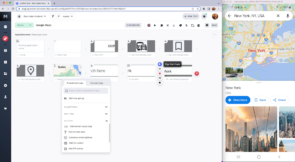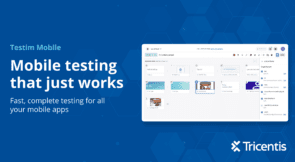There are many issues that we need to solve to ensure quality software for modern mobile applications, especially given the diverse range of mobile devices in a highly fragmented market. While this is a significant challenge, there are ways to deal with it. So let’s answer the question: Is Your Mobile Application Test Coverage a Mirage?
The Problem
In general, mobile testing is a real beast. First you have to deal with the major hardware vendors. There are iPhones, Androids, countless models, screen sizes that range from tiny to “is this a tablet now?”. Every time you sit down to look at the device, it seems like the OS version has been updated. Most people testing mobile devices have felt that sinking feeling when they try to overcome this challenge. It seems like no matter how many devices you test on, it is still a risk when the application gets released to end users. That’s the mirage: Do you REALLY have the test coverage you think you do? Let’s unpack this a little bit and try to get past this illusion and into what real quality for mobile looks like.
Are We Even Close?
Let’s assume your team is already running tests on a few devices—maybe the latest generation iPhone, a couple Samsungs, and that one emulator that represents a few high profile clients that like to log tickets with support at the drop of a hat. Your initial checks pass. Everyone breathes a sigh of relief, and then it’s time to ship it out. A few days later the reviews start coming in on the mobile app store:
“Crashes on my Pixel!”
“The blue button doesn’t work on my iPad!”
Suddenly, “good coverage” looks more like fools gold in a babbling brook. It’s a desert mirage. It is promising. But, it is not real. The mobile landscape has become a “soup” of manufacturers, models, OS flavors, all trying to compete for market share. And each one seems to have some kind of hardware quirk. Even when testing on a dozen devices or more devices, this is just a start. It might feel good, there are still more configurations – ones you never thought of, and your users and on those. And they all have access to the comment section of the app store.
This isn’t just a problem about quality assurance. It’s also a user problem. If a defect on a popular device slips through on a production release, you are not just not just dealing with a ticked-off customer; you may be risking user abandonment. Unless your application has a firm monopoly on the market, the cost of switching to another provider means people don’t have to put up with buggy applications (or slow ones). They just delete your application and move on to the next one. The stakes are higher in 2025, and this illusion of full coverage can leave you exposed. This isn’t just about doing more testing; it’s about doing smarter testing. But let’s back up and review why the old ways are no longer working.
Manual Testing Is No Longer An Option
For mobile application development, manually testing across a bunch of devices is like pushing a rock up a growing hill. Setting up a device lab with real phones, real tablets, and looking at real testing results is a great thing to do. However, this requires overhead. The devices need charging, updating, and debugging. Someone has to be the lab caretaker. This is all assuming you even have enough devices to cover the bases. Renting or buying more? That’s a budget conversation no one wants to have and it’s going to come up multiple times a year.
Modern software delivery is about being continuous. That means, continuous development, continuous testing, and continuous delivery. The infinity wheel in the DevOps model is spinning every faster. The lack of time is the real issue. Mobile moves fast. New devices drop, OS updates roll out, and your company has their deadlines. Manual testing is not going to scale. There may be things you still HAVE to test manually (for whatever reason), but in order to keep up, you have to get solid automation running – and fast. How much more of your user base will you get to just by adding automation? It’s the only way to beat the challenge of too many devices to keep up with.
The Virtual Lifeline
There are multiple mobile automation tools that will allow you to run tests across multiple devices. That is the first step. No, we have to deal with device management. Setting up a combination of real devices or emulators (or a combination of each) is also a headache. Multiple configurations, compatibility issues, and the overall maintenance is still a time vampire. You might be automating tests for 20 devices, but what about 200? 500? 1000? That’s a pipe dream for most organizations. That means coverage is still all over the place. The mirage still exists.
Cloud-based Virtual Mobile Grids (like what Tricentis Testim Mobile brings) can turn the tables. Imagine accessing a massive pool of virtual iOS simulators and Android emulators without wrestling with hardware or server racks. No dusty device shelves, no endless updates—just a browser tab and a test suite. It’s not about replacing something like Appium (it actually plays nice with it); it’s about greatly improving your testing reach. Suddenly, hundreds of configurations for coverage isn’t a fantasy. That means defects get caught before users encounter them. It is less about guessing now, and more like a good plan.
It’s Not Just About Running Tests
People love metrics. It’s been said “What gets measured, gets done.” I love metrics, but they do not always mean you will get the right outcome. Higher number of test cases created or higher number of defects found doesn’t always mean better quality software. What if the testers are financially motivated to find more defects to increase their salary?
More devices don’t automatically mean better coverage. You could test on 1,000 configurations and still miss critical defects if you’re not strategic. It isn’t just about execution; it’s about thinking. Who’s using your application? What devices show up the most in your analytics? Where’s the biggest risk? Is it older OS versions or budget Androids specifically? Digs into the user data, market trends, and failure patterns to prioritize what matters. Testim Mobile can give you the tools to hit tons of devices, but without a good plan, you’re still reaching the dark..
It’s less about brute force and more about being precise. For example, use the pareto principle to focus on covering 20% of the devices that serve 80% of your users. Then drill down into the edge cases that are responsible for most of the bad reviews. If you get this right, you are doing your best to protect the end user experience. Users notice when an application just works. That’s your payoff.
Find The Testing Oasis
How do you know if your test coverage is real? Counting devices tested is a start. Go deeper. What percentage of your user base are you actually hitting? What are the main configurations where bugs usually hide? Tie it back to user impact. How many defects (or crashes) generally slip into a release on the untested devices? Metrics like these give you the confidence to know where you are at in terms of quality. You need actionable data capable of showing the wins and highlighting the gaps.
With a tool like Testim Mobile’s Virtual Mobile Grid, you can track all of this without breaking a sweat. You can act on it—adjusting your strategy, plugging holes, and proving your work’s worth. Users get an application that isn’t flakey on their old phone, and you get to sleep knowing you’ve got their backs. The mirage turns into a real oasis at that point.
The Bigger Picture
Mobile testing has a messy landscape of unending devices isn’t going away. Devices will keep multiplying, and users will keep expecting everything to be perfect. However, you now have hope. You can get past the illusion of coverage for something real: scalable tools, sharp strategies, and metrics that matter. Tools like Testim Mobile can help you reach further without losing your mind, but it is all about how you use them. Solve these problems, and you’re not just shipping an application — you’re delivering trust. Isn’t that what QA is supposed to be about?
Give Tricentis Testim Mobile at try at this URL; https://www.testim.io/testim-mobile/?utm_source=blog&utm_medium=organicsocial&utm_campaign=testim_testauto_testim.io-mobile-blog-cta-_blog_ams_en_2025-05




